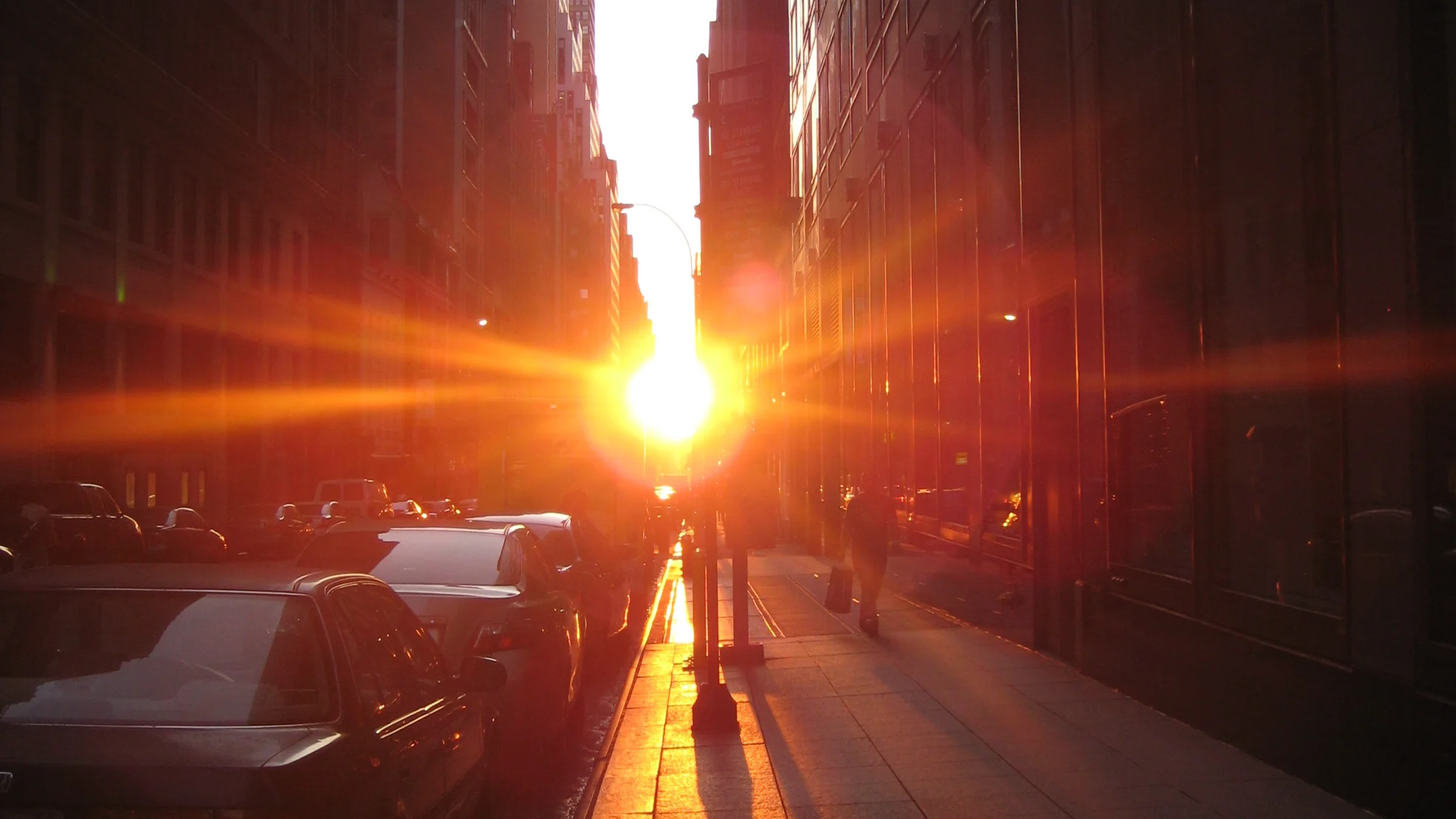
Are you ready for Torontohenge? Here's when you can see it
Cameras at the ready for this spectacular solar alignment, and be careful on the roads this weekend!
The city of Toronto is due for some amazing sunsets this weekend, as it experiences the phenomenon known as Torontohenge.
Twice each year, in mid-February and again in late October, the setting Sun presents a daunting challenge to evening commuters traversing Toronto's downtown core. How do you keep the setting Sun out of your eyes, which is shining directly down the streets, while simultaneously ensuring that you can still see the traffic, pedestrians, signs, and signals around you?
Whether travelling via horse-drawn coach or cart during the city's early years, or driving a motor vehicle in the city core in 2025, it's been this way ever since Toronto's grid was first established. However, over the past few decades, it has also turned into a cultural phenomenon, known as Torontohenge.
Years ago, astrophysicist Neil deGrasse Tyson coined the term Manhattanhenge. It described how the skyscrapers lining the island's downtown city streets would perfectly frame the setting Sun on certain days of the year. Although the effect is coincidental, simply due to how the Manhattan streets were arranged, it is still very similar to what is seen during the summer and winter solstices at the ancient megalith, Stonehenge.
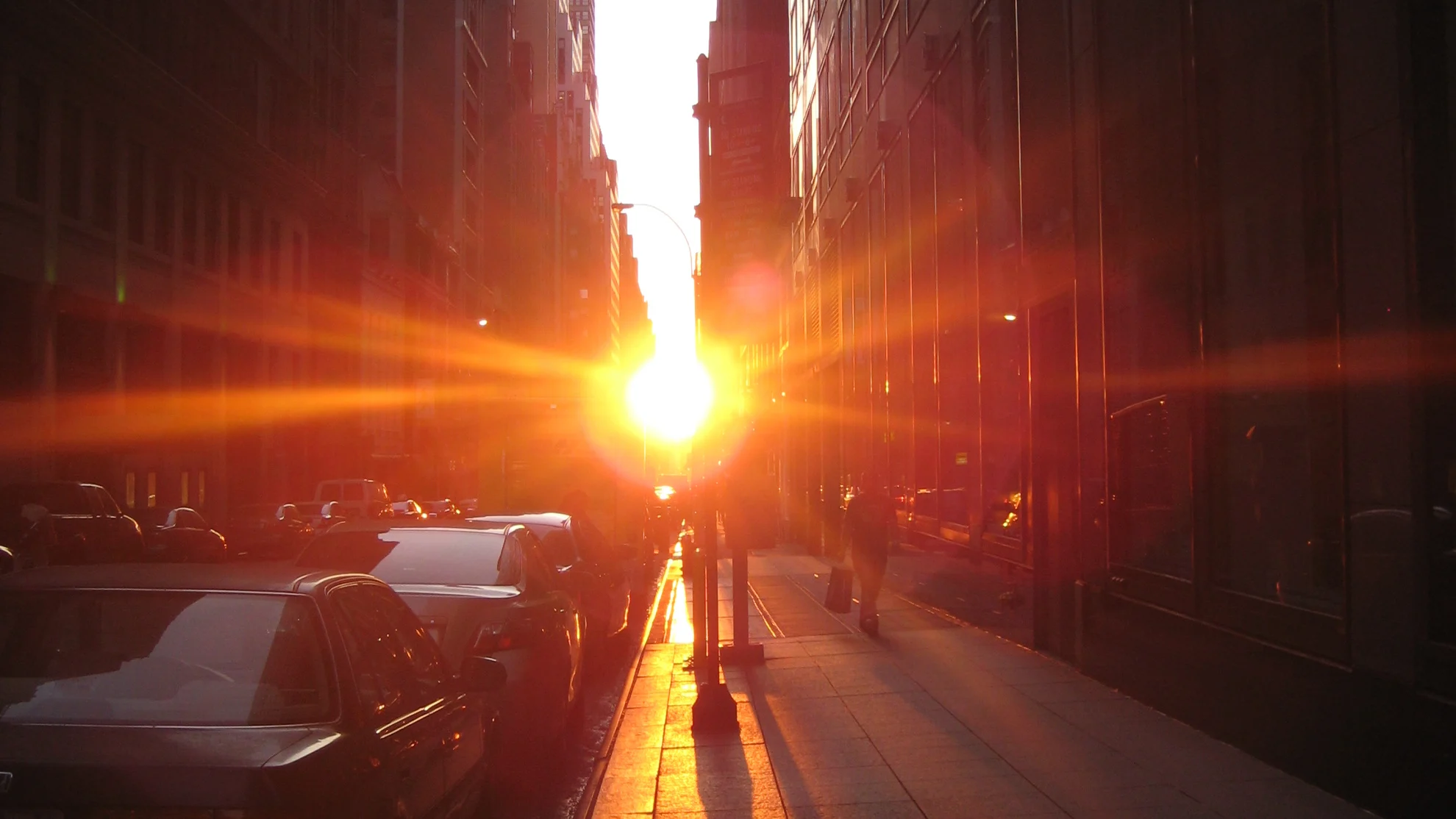
Manhattanhenge along 42nd St, June 3, 2008. Credit: Sevtibidou/Wikimedia Commons
DON'T MISS: Winter-proof your home with a heat pump that even works in -30°C
This isn't unique to Manhattan, though. Most cities that have tall buildings arranged in a grid can experience the phenomenon, although the exact timing differs based on location. For Manhattan, it typically occurs around May 28/29 and July 11/12, each year.
Since Toronto is arranged at a different angle, aligned with the shores of Lake Ontario, Torontohenge occurs around February 15 and October 25. Unlike Manhattan, Toronto also sees this same effect with the rising Sun, around April 19 and August 23 each year.
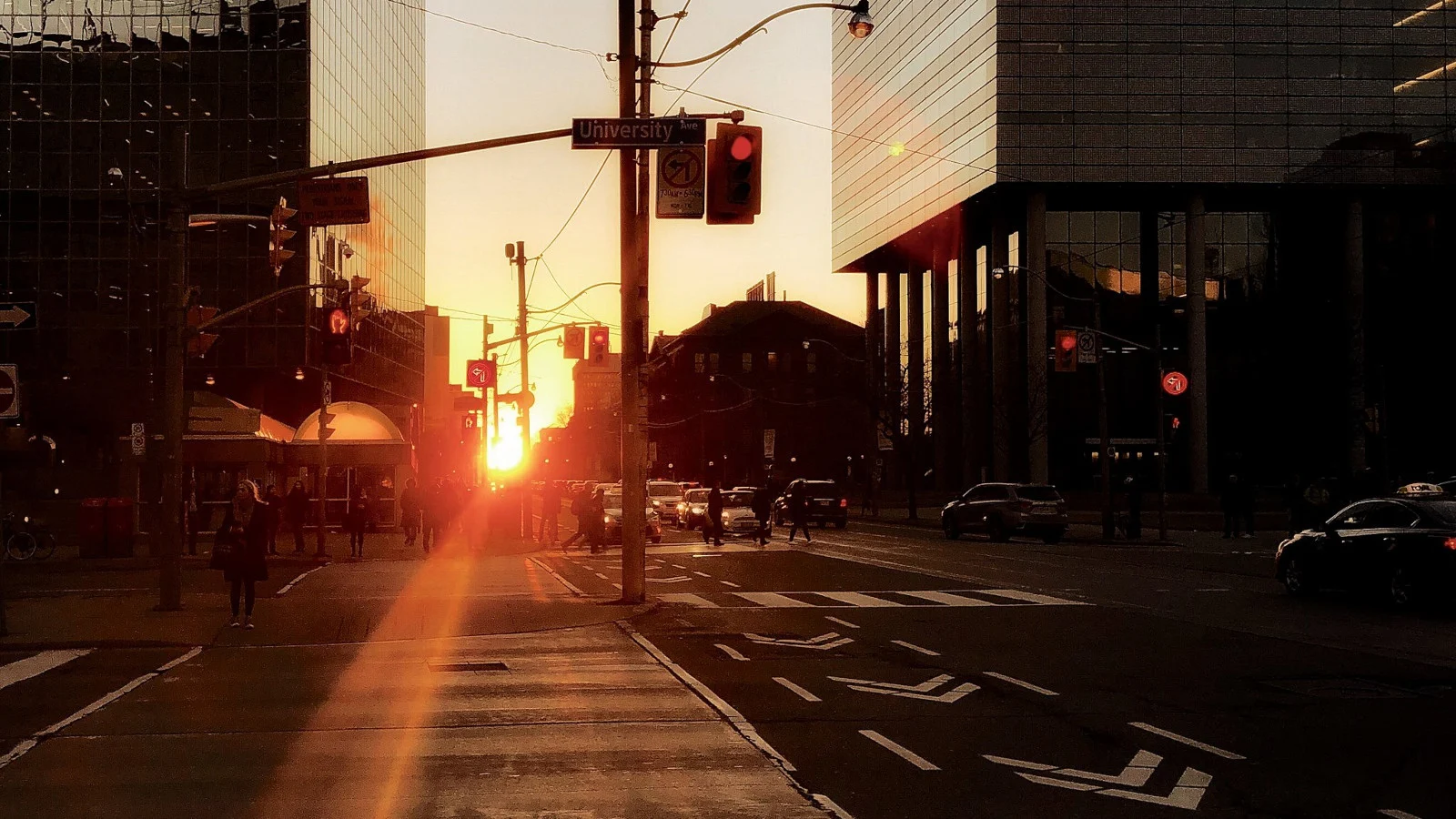
Torontohenge from College St in downtown Toronto, captured on February 22, 2018. Credit: NextThingIKnow/Wikimedia Commons (CC BY-SA 4.0)
SEE ALSO: Quirky weather stats to watch as the Toronto Blue Jays take the field
Rather than occurring on just one day, though, according to Ralph Bouwmeester's Sun and Shadow blog, we can experience Torontohenge for at least a few days before the October event, and a few days after the event in February.
Since the Sun sets at a slightly more southerly location each night at this time of year, we will first see the full disk of the Sun well above the horizon as it aligns with the city grid. It then gets closer to the horizon on subsequent nights, until we see what Neil deGrasse Tyson called the "Full Sun on the Grid" and "Half Sun on the Grid" alignments.
Full Sun on the Grid occurs when we can see the Sun's full disk touching the horizon as we look down the city streets. The next night we will have a Half Sun on the Grid, when the Sun will be half below the horizon as it aligns along that same view.

This diagram shows how the setting Sun gets lower in the western sky as it aligns with the city grid each day from October October 23-26, 2025. Credit: Scott Sutherland
For this particular Torontohenge, the city's sunsets occur at:
6:20 p.m. on Thursday, October 23,
6:19 p.m. on Friday, October 24,
6:17 p.m. on Saturday, October 25, and
6:16 p.m. on Sunday, October 26.
Remember that 'sunset' is defined as the time when the Sun has completely dipped below the western horizon. So, to experience Torontohenge, find your spot in the downtown core at least a half hour beforehand. That way, you can get the full effect as the Sun slowly comes into alignment between the buildings.
DON'T MISS: Last chance to spot Comet Lemmon for over a thousand years is here!
Where to see it
The best downtown locations to view Torontohenge tend to be along Wellington Street, King Street, Adelaide Street, and Richmond Street, when viewed from locations to the west of Younge Street. Each of these roads is straight, with tall buildings lining both sides, and both Adelaide and King have reasonably unobstructed views of the western horizon.
On King Street West, picking a spot just north of Roy Thomson Hall is often especially good.
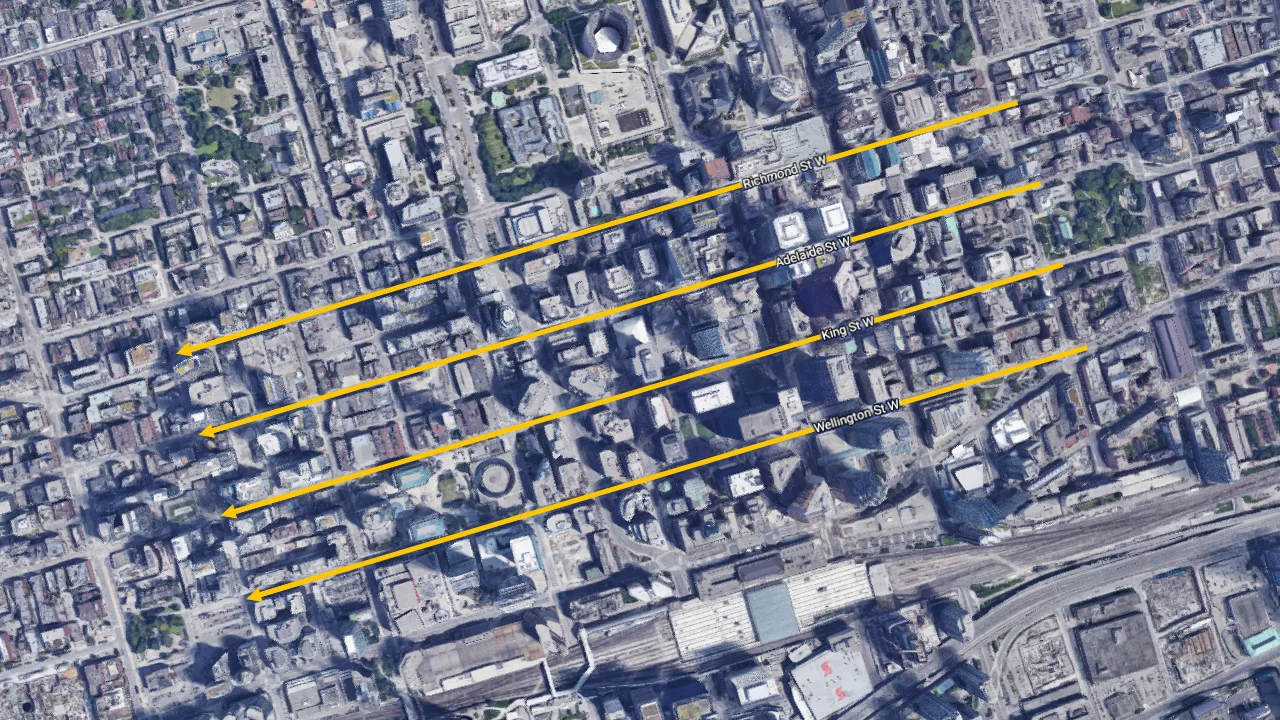
This map shows the best streets for viewing Torontohenge from downtown Toronto. Credits: Google/Scott Sutherland
For those located farther north, Bloor Street West, near Yonge Street, is another great spot.
Any similar street will produce the desired effect, though.
Clear or cloudy?
As of The Weather Network's forecast for Toronto from Thursday, October 23, it appears as though the city will have excellent weather for Torontohenge.
The table below compiles the evening forecasts for October 23-26, from Toronto's 7-day forecast page.

TORONTO WX: Quirky weather stats to watch as the Blue Jays take the field
Check for any updates to this, and be sure to check your local forecast before going out, just to be certain.
What's going on here?
Throughout the year, the Sun's position in the sky changes. During the June solstice, it is highest in our northern hemisphere skies, and day by day, it tracks lower and lower until we reach the December solstice. Then, the process reverses, with the Sun's path climbing higher and higher each day until we are again at the summer solstice.
This change in the Sun's angle and its effect on the intensity of the sunlight when it reaches the ground is what produces our four seasons.
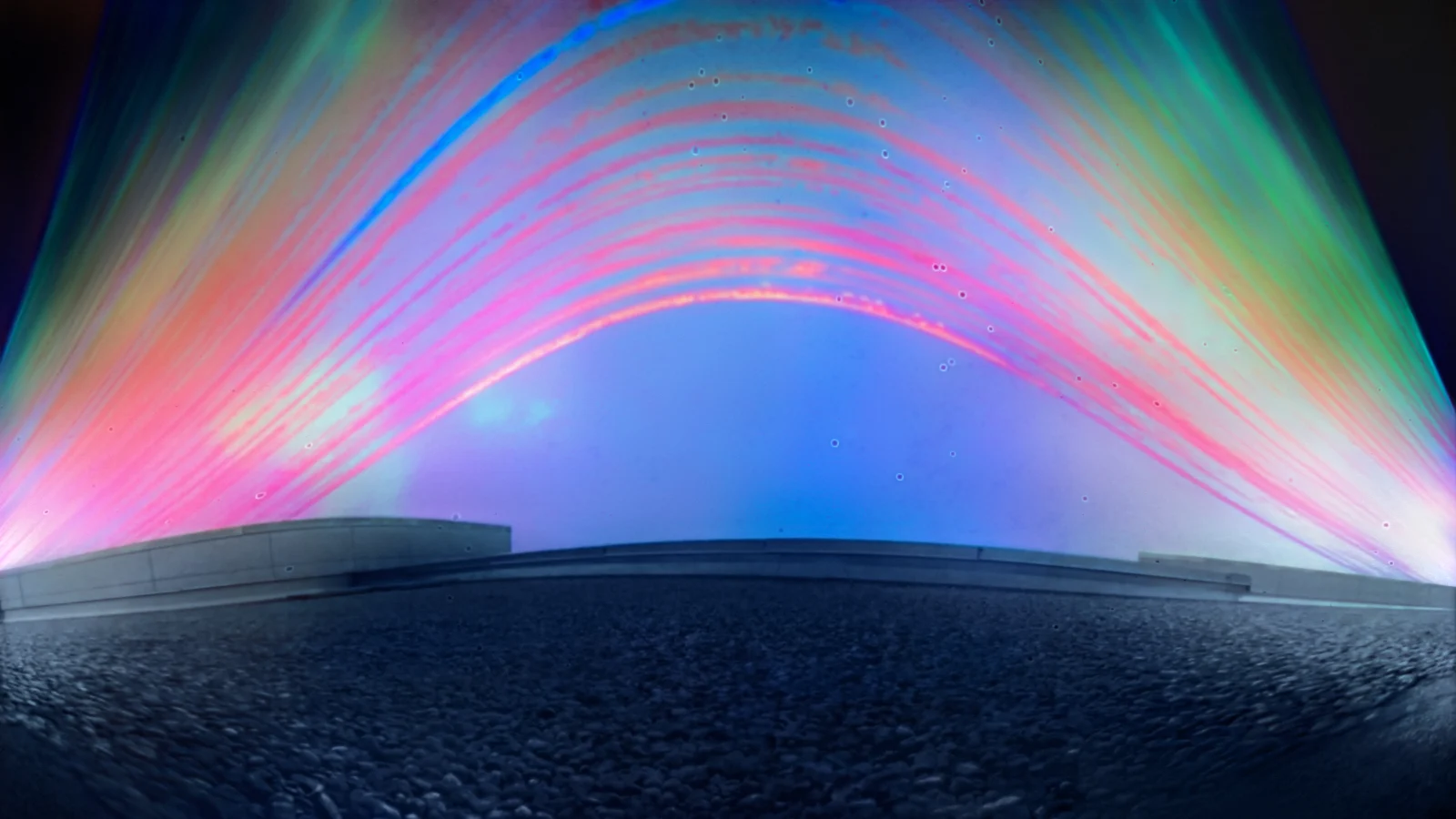
This 'solargraph' image captures the Sun's path across the sky, day after day, between the dates of June 21 and December 21, 2023. Credit: Bret Culp (Used with permission)
So, with each sunrise and sunset we experience, we see the Sun at a different point along the horizon than it was the day before.
When ancient peoples realized this trend, they set up monuments that would line up with the rising and setting Sun on specific days of the year. The most common days to observe this alignment were on the summer and winter solstices. More sophisticated monuments also observed the spring and fall equinoxes.
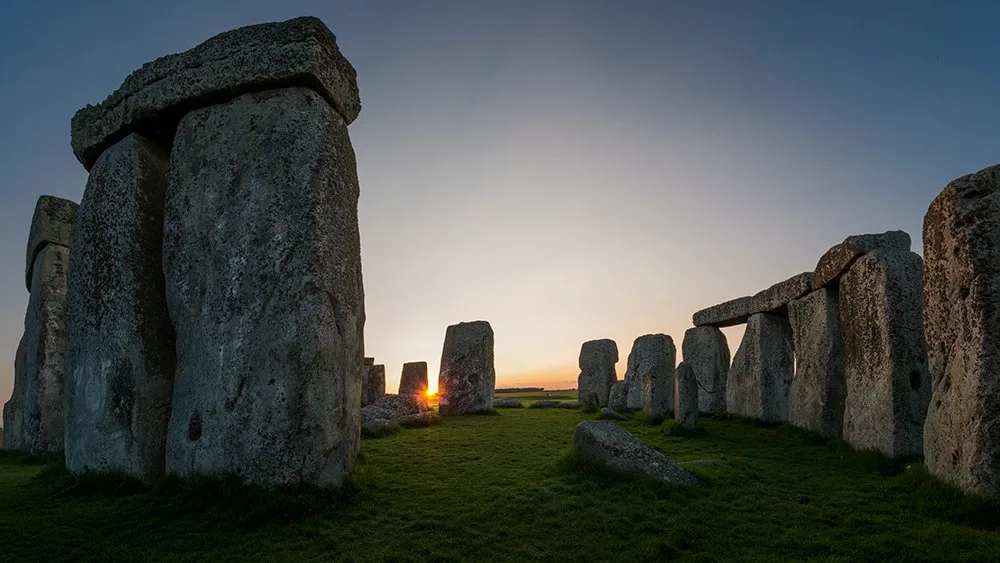
Credit: English Heritage
However, cities such as Toronto and New York weren't built with astronomical alignments in mind. Their orientation was dictated by the local geography, specifically the shape of the Lake Ontario lakeshore and the shape and orientation of the island of Manhattan.
Coincidentally, the Sun does line up with the streets of these cities on specific dates. They just aren't astronomically significant dates. This 'henge' effect of those alignments would also not have been as noticeable when the city's streets were established. It only became a phenomenon as taller and taller buildings began to line those streets.
FROM SPACE: Alien comet 3I/ATLAS just swept past Mars. When will it return to our skies?
More than just Manhattan and Toronto
Other locations in Canada experience these 'henges' as well. As long as the community is reasonably grid-like, and there are straight roads lined with buildings — the taller, the better — there's a fair chance it experiences a 'henge' at some time during the year.
For example, although there are fewer tall buildings there, Halifaxhenge happens on the exact same dates as Torontohenge.
Montrealhenge occurs at sunset on Summer Solstice and sunrise at Winter Solstice, as the Sun lines up with streets running northwest-southeast, such as Robert Bourassa Boulevard and Peel Street.
For Calgaryhenge, the Sun aligns between the buildings on 4th, 5th, or 6th Avenues at sunrise around March 14 and sunset around March 21. It occurs again at sundown on September 21 and sunrise on September 28.
Edmontonhenge is best seen (both sunset and sunrise) right around the March and September equinoxes.
A plea for caution!
With the setting sun shining straight down the streets of Toronto, the glare will undoubtedly make evening commutes more challenging this weekend.
For pedestrians and those looking to see and capture Torontohenge, please be cautious and give commuters extra space and consideration.
This is especially true when photographing the event, as there may be some temptation to step out into the street for a better angle. Due to the glare from the Sun, you may not be as visible to drivers as you think!
And for commuters, whether the Sun is directly in your eyes as you drive west or in your rearview mirror as you go east, extra care is undoubtedly called for right now! Especially when driving downtown, pedestrians may not realize just how much the glare affects you, and there may be Torontohenge enthusiasts trying to get a better look at the phenomenon.
Please watch out for one another so that everyone stays safe!
(Thumbnail courtesy Sevtibidou/Wikimedia Commons (CC BY-SA 3.0))
